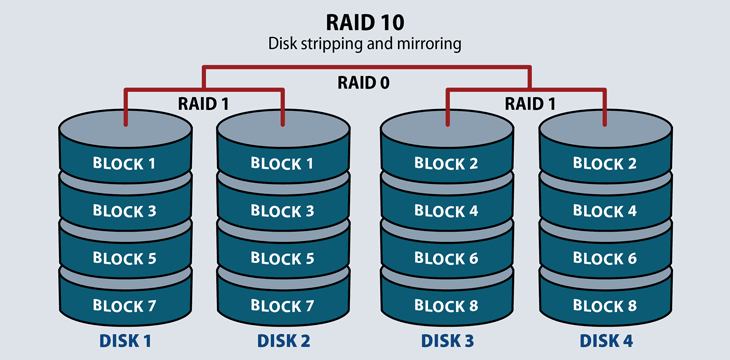RAID is a short form of Redundant Array of Independent Disks. It is essentially a way of storing data on multiple disk drives for better performance or protection. There are different levels of RAID, usually numbered 0 – 9. Raid 10 is essentially a combination of RAID 1 + RAID 0 – hence the name RAID 10. For us to better understand RAID 10, Let us discuss briefly RAID 1 and RAID 0.
RAID 1 is a concept whereby two or more drives in a network store data in a mirrored (duplicate) way. Data that is written to Drive 1 will also be written to Drive 2 and other drives. This process is called “mirroring” in which case if Drive 1 fails, then Drive 2 takes over hence offering complete redundancy of your data. Few important concepts to remember in this type of set up: There must be a minimum of two disk drives and the overall total capacity (maximum capacity) of the network is same as the smallest capacity hard drive in the RAID. In other words, do not expect the total capacity of the network to increase as you increase the number of hard drives in the set up. Reason behind increasing number of disk drives in the RAID is not to increase the storage, rather to have as many drives mirrored for data redundancy. The primary purpose of implementing RAID 1 would be to improve read speeds and improve security of the stored data.
RAID 0 is a concept whereby data are broken into blocks (stripes) and different stripes are written to different drives simultaneously to increase read and write speed. So multiple stipes are written to different disks and can be read from different disks simultaneously. In this type of set up, there is no redundancy, in other words one disk drive failure can cause the entire system to fail.
So, what is then RAID 10?
RAID 10 is a concept of RAID by combining mirroring (RAID 0) and striping (RAID 1) to provide data protection while improving performance. This set up requires a minimum of 4 disk drives and it stripes data across mirrored pairs. RAID 1+0 (RAID 10) mirrors two drives together and then creates - striped set with the pair. Also note that if one disk fails in the mirrored set, you will be able to retrieve the data, however, if both drives in a mirror fail, then data will be lost. In addition, note that RAID 10 stores all data in duplicates, therefore retrieving or rebuilding data in RAID 10 is faster however, since all data is stored in duplicates (mirrored) then you are practically using 50% of the storage for the actual data and the other half to store the duplicate data.
Where can one use RAID 10?
If you are looking for data security combined with read/write data speed, then RAID 10 is the way to go. IT managers prefer RAID 10 set up in database and application servers. These servers usually host data that users are constantly accessing (reading or writing to the data), hence they are mission-critical servers, and they need to be up and running 24x7x365.
What do I need to set up RAID 10?
You obviously need a host system, usually a server, at least 4 enterprise-level hard disk drives, and a RAID Controller. When making a choice for hard drive, make sure you purchase 4 drives that are exact same model numbers or part numbers to avoid any issues in configuring RAID. Most servers support SAS Interface hard drives 2.5 inch or SAS Interface hard drives 3.5 inch. If your server is a branded server such as HPE, IBM, Dell then I'd suggest your hard drives and RAID Controller be of similar brand. Branded servers are of different types and each server may or may not support a particular RAID Controller. A careful research is needed before purchasing the hardware.

